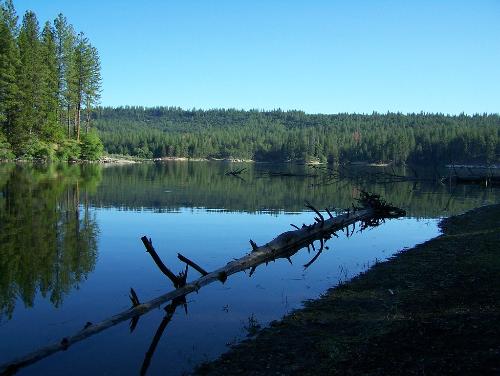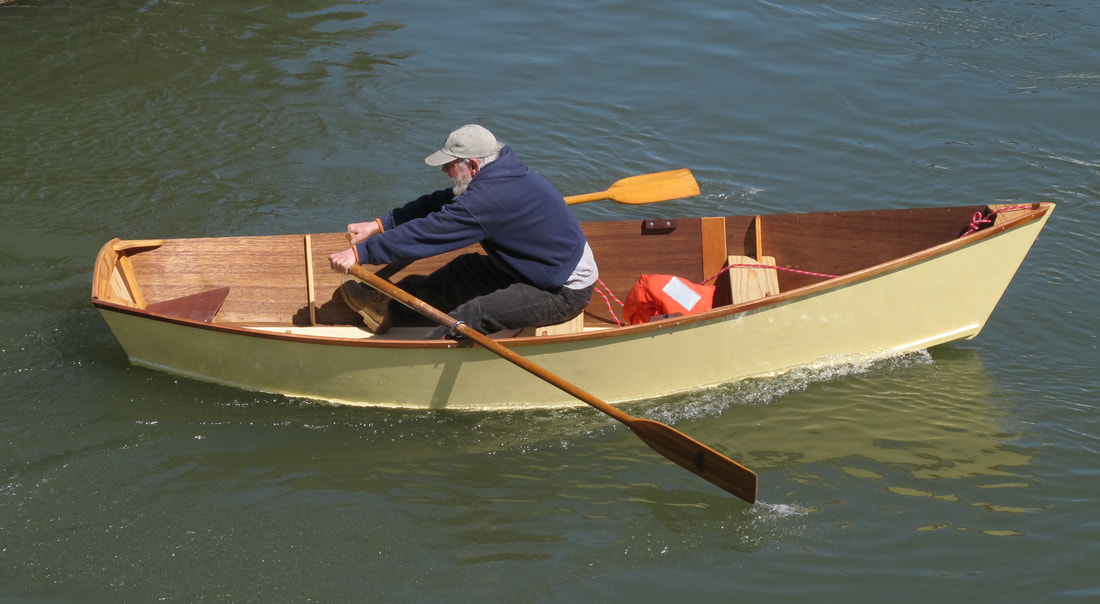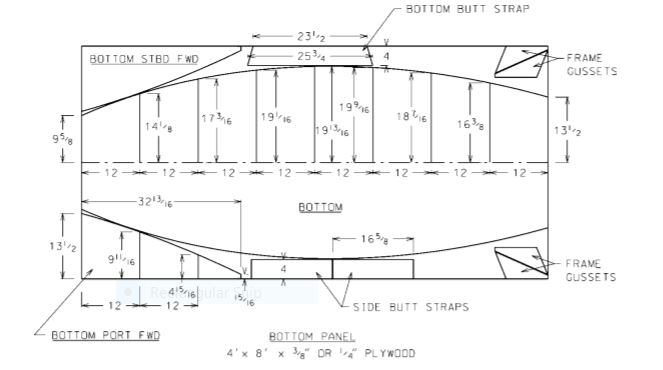The 'Pepper Bay Pram'
|
This post was updated on .
'Home water' for me is the Burney Creek Cove of Lake Britton. It's small water, where my 8' foot prams are just the right size for a morning or evening of fishing.
 Compare that with the expanse of the Willamette where that same size pram looks like a toy. Exacerbating the problem of size relative to where the boat is put in is the differences in launch sites: narrow, sandy beaches at Britton vs Willamette Park's long, steep, concrete ramps that chew up wooden bottoms. The obvious solution is I need a different and bigger boat, maybe something around 12'. 
But I don't need as much stern rake, nor the long bow overhang, nor the fore and aft thwarts, nor as much freeboard. In short, I need a boat with as much length on the waterline and as much effective cargo space, but not as much overall length. That means re-drawing Chris Franklin's Salt Bay Skiff to become a Pepper Bay Pram. Here's what I think makes sense about the SBS: the straight line cuts used to the side planks ensure sufficient rocker and an attractive sheer; the external chine means jigging can be causal. Here's what I'd change: ease the stern rake, transom the bow, double the skegs, scupper the gunnel, get rid of the F&A thwarts, maybe frame radially rather than axially, cut handholds in both transoms, shoe the keel, install foot stretchers, raise the oarlocks, add rubbing strips and seat risers. |
|
This post was updated on .
Various methods exist for defining a 'fair curve'. Shop-floor/lofting-floor methods and mathematical ones. (1) If a batten sprung along a series of plotting points easily contacts all of them, then the plotting plots can be assumed to describe a constructible, fair line. (2) If a regression line can be imposed on a series of plotting points with less than 0.1% error, the curve is "fair enough". But if 2nd order polynomial can be constructed from any three of the plotting points and predicts the other points exactly, the curve is "exactly fair".
Given that shop-floor/lofting-floor layout work needs to allow for the imprecisions imposed by things like saw kerfs and the width of pencil lines, the precisions that can be obtained in a graphing program can't be fully translated to the drafting table, and the crispness of lines obtained on the drafting table can't be achieved on the building frame. However, when errors in unfairness greater than 1/16" are discovered in a table of offsets, they should be corrected. If they are greater than 1/8", the integrity of the plans should be questioned. If a 2nd order polynomic trendline is imposed on Franklin's plotting points for his bottom plank, it is seen they are unfair by as much as 2" inches and would require making use of 3rd order polynomial to render them fair mathematically. So, a materials science question arises. Which set of equations best describes how lumber and plywood actually bends in the shop and on the building frame? Frankly, I assume the less curve-fitting, the better, and prefer to fair curves on the drafting table rather than force battens on the layout table or planks on the building frame. What this means with respect to building a Salt Bay is the transom needs to be 4-1/16" wider than he drew it, while keeping the aft, mid, and forward frames the same. If the transom is widened, then the plotting points for the bottom need to be re-calculated. But with a graphing program to feed a marine CAD program creating a new table of offsets and new set of expansions requires just a couple of mouse clicks. Result? Possibly, a better boat, which sea trials would determine, but certainly one whose lines I'd trust more than what is seen in the plans. So, this question has to be asked: Why did Franklin tuck the stern? Because ..da, dah.. he was trying to cut the bottom from a single sheet of ply and failed to make the most efficient use of his materials. He had to tuck the stern in order to have enough material from the off-cuts to piece together the fwd portion of the bottom. There is no reason anyone else who builds his boat should make the same error, which is a classic instance of 'Grandma's roast pan'.  How could he have avoided his mistake? By laying out the bottom on a sheet and a half, which --if you'll read his manual of instructions-- is what he does anyway. Alternatively, a bottom with a wider transom can be cut from a single sheet if the butt blocks and frame gussets are gotten elsewhere. But "No". He had become fixated on the size of boat produced by his original idea of a 'single sheet bottom' and failed to optimize its shape --toward a fairer hull-- when he changed how he used his materials. And, actually, there's even a third way to get a bottom as long as 12' and as wide as 36"-38" from a single sheet of ply. But I'll leave figuring that out to the reader as an exercise. LOL |
|
This post was updated on .
I'm intending the Pepper Bay Pram to be a more of a 'pulling boat' than a 'fishing boat'. So a discussion of oars becomes necessary.
Traditionally --at least in America-- oars are manufactured and sold in 6" increments, beginning with 5.0s and topping out at 10.0s. This is done for the convenience of manufactures and vendors, not for the needs of oar users. Worse, oar lengths are nominal', not 'actual', for being shorter by an inch and half or two. The industry standard formula for sizing oars to a boat is half the beam plus 2" where that portion of the oar equals 7/25ths of the overall length. That results in a "theoretical" gearing of 28%, and I prefer 30%, never mind the fact that oars are a 2nd class lever, not a 1st class one. The "common sense" approach to sizing oars would suggest that longer is better, because more leverage means more speed. But that speed comes at a cost of effort, and unconditioned rowers can't swing long oars and/or big blades sustainedly. Fortunately, recent research suggests that shorter oars might be a path without penalties. https://www.concept2.com/oars/how-made-and-tested/blade-path |
|
In reply to this post by Charlie43
It's become a New Year with all the hope and promise that implies. By the end of next week, there'll be a canopy over the working area of our new shop, and shortly after, the end walls will be in place. So it's time to think about building a boat.
Rivers West's signature boat is the Salt Bay Skiff (SBS). Chuck markets it to families as a rowboat. But that isn't what the designer (Chris Franklin) intended, which is a sloop-rig sail boat for one parent and one small child. Yes, the boat can be rowed, and it's a fun boat to row as a single (as the photo above of me rowing a SBS shows). But it isn't as good a rowboat as it could be if some changes were made (that I also discussed above). So, this year, rather than just talk about it, I'm going to make it happen. Just as soon as building frames can be set up on the new shop floor, I'm going to haul in two sheets of ply and start building the Pepper Bay Pram (PBP). To build a boat, (typically) you need a set of plans. So that's today's project: drawing a boat I'd be willing to build and use. It takes 2-1/3 sheets to build a SBS and lumber that's 14' feet long. Those are inefficiencies if a single-user boat is intended, especially with prices rising as they are. Therefore, I'm going to impose this constraint on the design. The planking (i.e., bottom, sides, bow/stern transoms) have to be cut from just two sheets of ply, and the chines, gunnels, and frames have to be cut from stock no longer than 12' feet. That reduction in materials will translate to a savings in boat cost and boat weight. But it also means the boat will offer less displacement. Translation: this will NOT be a boat meant for two adults. At most, it will be the boat Franklin intended, a boat for a single user, or one parent and one small child, or two kids. Charlie |
|
This post was updated on .
After months of dealing with the financial casinos and putting up with our endless rains, I'm ready to get back to designing and building boats. So the Pepper Bay Project is back on, with a new target audience in mind, the bass guys, who are a friendly bunch, but more inclined to hang an outboard off the transom for propulsion than depend on just oars. That means the transom needs to be beefier than what Franklin drew, as does the whole boat, which he planks with 1/4" and similar scantlings. But the added weight shouldn't be a problem, because the boat's intended users are likely to be hauling the boat in the bed of a truck, rather than cartopping it.
Flat-bottomed boats pound in a chop, which is the normal conditions on our local waters. But flat-bottomed boats are easy to get up on a plane. Vee-bottomed boats move more easily under oars, but offer less initial stability if one intends to stand to cast, never mind their being harder to build than a flat-bottomed boat. A skiff is no harder or easier to build than a pram, but it does sacrifice 'burdensomeness' for 'sea-keeping' ability. Lastly, Franklin's design requires 2-1/2 sheets of ply, which makes it more expensive to build than a design that uses exactly two sheets. So, not only doesn't Franklin's boat safely accommodate two adults --as has been confirmed by multiple field reports-- it wastes half a sheet of ply. Thus, this becomes my design objective: as much of a boat that can be built with two sheets of ply that maximizes 'single-user sea-worthiness', 'high initial stability', 'anti-fragility when launching/beaching', 'robustness under power', 'nimbleness under oars', and 'efficiency and ease of construction'. Charlie |
|
Nice images!
|
«
Return to General discussion
|
1 view|%1 views
| Free forum by Nabble | Edit this page |

